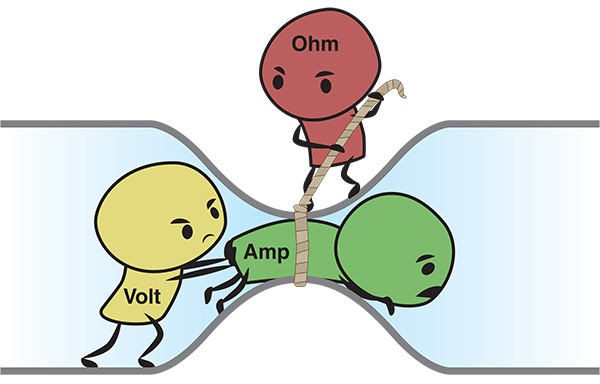You have to understand a bit about voltage and current to understand why this is true.
The typical comparison (which isn’t 100 percent accurate but helps to understand the concept) is that if you have a water hose, the “voltage” is equivalent to the water pressure and the “current” is how fast the water is actually moving. In any given situation, they tend to be related. If you have higher water pressure, you end up with the water moving faster through the same size hose.
The cartoon that @Llama_Llogophile posted is basically saying the same thing.
Let’s take the simple case of an old fashioned incandescent light bulb, since this type of light bulb is basically a simple resistor. Wires aren’t superconductors, so wires also have a resistance. If you have a really long wire, the resistance of the wire can be bigger than the resistance of your light bulb. So what happens is more power gets wasted as heat in the wire than gets to your light bulb. That’s bad. You want as much power as possible getting to your light bulb.
The next thing that you need to understand is the AC transformer. This is a simple device. It’s literally just two coils of wire around an iron core. This increases or decreases the voltage based on the number of turns of each wire. In other words, if one coil of wire has 10 times as many turns around that iron core as the other wire, the transformer will increase or decrease (depending on which way you hook it up) the voltage by a factor of 10. But transformers can’t defy physics. They don’t generate power out of thin air. So if you boost the voltage by a factor of 10, the current goes down by factor of 10.
So imagine this system. You have your AC generator. You connect it to an AC transformer that boosts the voltage by a factor of 10. You transmit that across your long wire. Then at the other end, you have another AC transformer that reduces the voltage by a factor of 10. Now you are back to your original voltage, and you can connect that to your light bulb.
But if you end up with the same voltage, what’s the point of doing all of that increasing and decreasing the voltage? Here’s the thing. The power that gets converted into waste heat in the wires is proportional to the square of the current (the formula is literally i2R). So if you reduce the current in the wire by a factor of 10 in the wire between the two transformers, you decrease the power lost as waste heat by a factor of 100. That’s pretty significant.
So why don’t we do this with direct current (DC)? The simple answer is that there is no easy equivalent of an AC transformer for DC. Back in the old days, you could connect a DC motor to a DC generator and use that to change the voltage, but that’s big, clunky, expensive, and loses a lot of energy to mechanical friction. In modern times we can use semiconductor circuits, but for large amounts of power those are much more expensive than a simple AC transformer.
But we do actually use DC for long distance power transmission. It’s usually only done over very long distances with very large amounts of power, otherwise the cost of the DC “transformers” and switchgear is way too expensive and the system costs too much. But DC does have advantages, which I can talk about if you want.
So with your electrical service, a big AC generator takes power from somewhere (heat from burning coal, natural gas, or nuclear fusion to generate steam in a steam turbine, for example) and converts that into electricity, that electricity goes into big AC transformers which boost the voltage up to a very high “transmission voltage” level (50,000 to 200,000 volts or more) which keeps the losses in the wire down to a minimum. At a substation, the voltage is reduced by more AC transformers down to “distribution voltage”, which is typically somewhere between 3,000 and 12,000 volts. Distribution wires aren’t going such long distances, so they don’t need to be as high of voltage. The distribution wires run all through your neighborhood, with more AC transformers all over the place. Each of these smaller AC transformers gives power to typically 3 or 4 houses at most, and drops the voltage down to the final split 240 volt power that you get into your house.
If you tried to do that with DC back in Edison’s day, the cost of the DC motor-generator sets and inefficiencies in the system would prevent the system from being practical. That’s why Edison lost to Westinghouse, and that’s why we use AC in our homes today.
